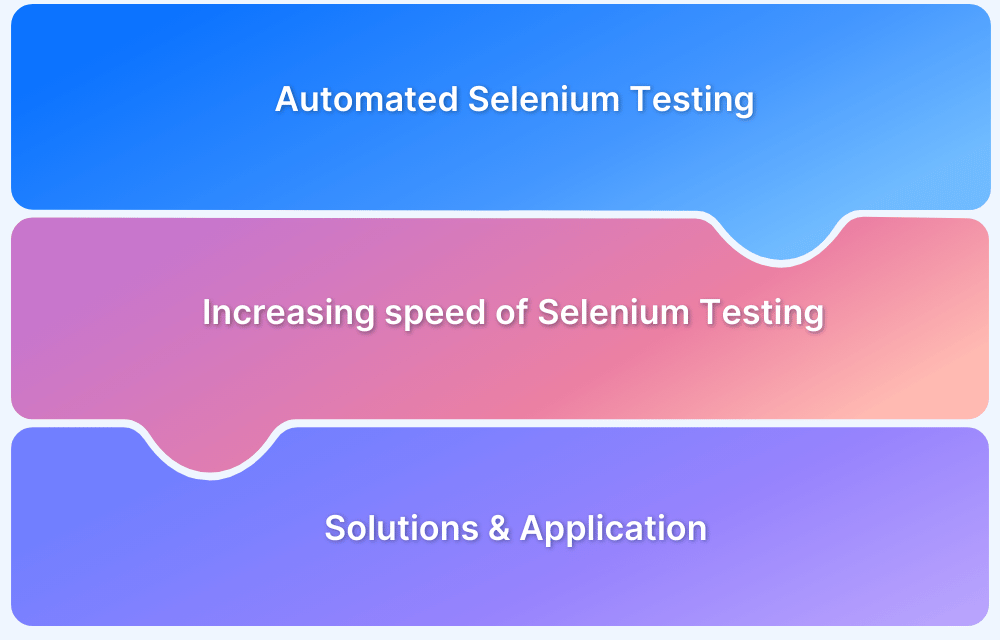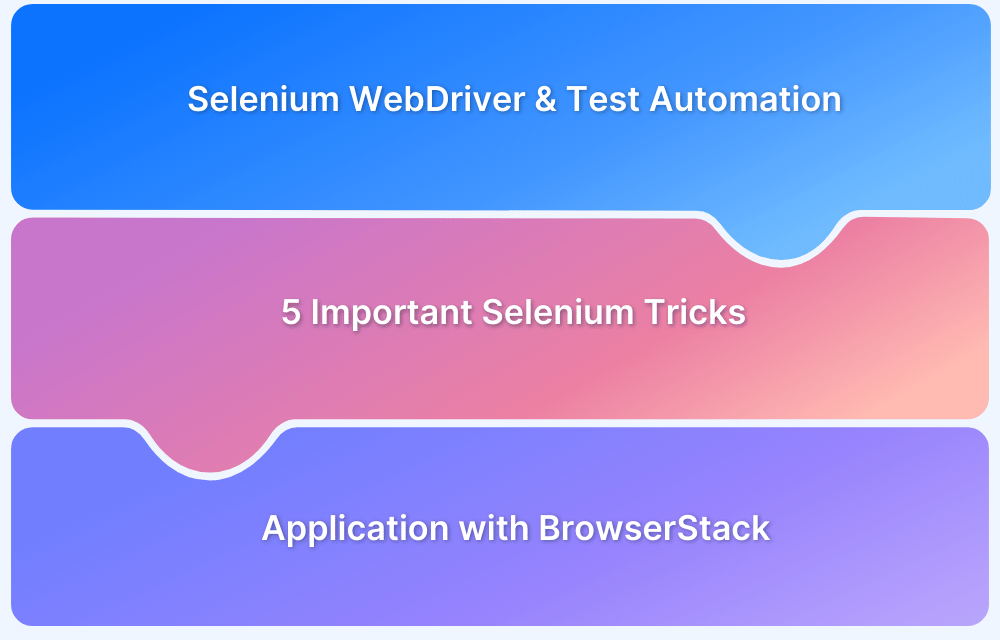Factors like network latency and usage of outdated drivers etc. can slow down Selenium tests. This can adversely affect your testing efforts, increasing the risk of flaky tests, prolonging execution time, and reducing productivity.
This article discusses the strategies to run your Selenium tests faster and reduce execution time.
How to Speed Up Selenium Test Cases and Reduce Execution Time?
The entire point of automated Selenium testing is to introduce speed into the software testing lifecycle. To this end, it is important to write and execute Selenium test cases for maximum speed. Here are a few methods that can accelerate Selenium test cases, and provide faster results, thereby, allowing faster time to market for new software.
Methods to Reduce Execution Time in Selenium:
- Write shorter tests
- Refine Test Scripts
- Utilize Parallel Testing
- Select Appropriate Web Locators
- Reduce the Usage of Web Locators
- Avoid Thread.sleep()
- Reuse The Existing Browser Instance
- Use only Explicit Waits
- Group Test Scenarios
- Upgrade to Selenium 4
- Use cloud-based Selenium Grid for Automation Testing
- Disable Images on the Web Page
- Use Data-Driven Testing for Parameterization
- Use Headless Browsers and Drivers
- Use fast selectors in test scripts
1. Write shorter tests
Ensure that each Selenium test is meant to test a single functionality. A helpful guide would be to keep the number of steps in each test under 20. While parallel testing can certainly speed up the process, keep in mind that a single test must run on a single device, not multiple ones. Therefore, it’s a good practice to keep tests short.
Additionally, short tests have another advantage. If the test fails, it is easier to pinpoint the problem to a specific line of code, if that is necessary.
2. Refine Test Scripts
To write Selenium tests that run faster, write independent Selenium test scripts that do not duplicate steps. Ensure that there are no steps or methods that are not directly related to the final outcome.
3. Utilize Parallel Testing
This is the easiest way to speed up Selenium test cases. Simply run automated tests on different device-browser-OS combination simultaneously, so that the entire test suite can be completed in much lesser time.
Essentially, if there are ten tests to be run, execute each one on a different device at the same time. If each test takes ten seconds to run, the entire test suite will be completed in ten seconds. If the suite had been run on a single device, it would have taken 100 seconds.
BrowserStack offers parallel testing with Selenium on Automate, enabling testers to run automated tests on 3000+ real devices and browsers using its Cloud Selenium Grid. Each parallel test comes with a user account, which gives the user access to unlimited Live and Screenshots, apart from Automate.
Try Parallel Test Automation for Free
4. Select Appropriate Web Locators
Leveraging suitable locators such as using IDs or CSS selectors makes the test run faster. But, tt can be slower for locators like XPath, especially when complex expressions are used. By choosing simple, efficient locators, you ensure that the time Selenium spends searching for elements is reduced.
Read More: How to use XPath in Selenium?
5. Reduce the Usage of Web Locators
Excessive use of web locators in tests can increase execution time. Try to minimize the number of times Selenium needs to locate elements. Where possible, store element references in variables to avoid repeated lookups.
6. Avoid Thread.sleep()
Using Thread.sleep() to wait for elements will slow down tests considerably, as it makes Selenium wait for a specified amount of time. Instead, use dynamic waits like WebDriverWait for better control over the timing so that tests only proceed when elements are actually ready.
7. Reuse the Existing Browser Instance
Creating a new browser for each test can add unwanted overhead. Reuse of the same browser over multiple tests reduces setup time over tests and improves the efficiency of the tests, specifically in large test suites.
8. Use only Explicit Waits
By using Explicit Wait commands, Selenium WebDriver is directed to wait until a certain condition occurs before proceeding with executing the test script.
Setting Explicit Wait is important in cases where there are certain elements on a website that naturally take more time to load. If one sets an Implicit Wait command, then the browser will wait for the same time frame before loading every web element. This causes an unnecessary delay in executing the test script.
As far as possible, using Explicit Wait commands will eliminate delays in running Selenium tests.
9. Group Test Scenarios
Grouping related test cases can decrease setup time. Testing the same thing in a different sequence can prevent duplicate steps and make tests run faster. This also makes it easier to maintain your test suite because it’s structured in a logical way.
10. Upgrade to Selenium 4
Selenium 4 provides substantial performance benefits compared to the earlier versions. It supports modern browser features, better handling of asynchronous events, and improved APIs.
Read More: Selenium 3 vs Selenium 4: Core Differences
11. Use Cloud-based Selenium Grid for Automation Testing
Instead of maintaining your own grid, opt for cloud-based Selenium grid provided by platforms like BrowserStack. So, you can run parallel tests across multiple browsers and environments, reducing execution time. This setup provides flexibility and scalability for large test suites.
12. Disable Images on the Web Page
It takes time to load images on a webpage. To boost test execution speeds, try disabling images in the browser. Images are not critical for functionality tests. It reduces the load time, which enhances test speed.
13. Use Data-Driven Testing for Parameterization
Data-driven testing allows you to run the same test with different input values, so it is more efficient than creating separate test cases for each variation. You can cover a number of different scenarios without increasing the number of test cases.
14. Use Headless Browsers and Drivers
Headless browsers run tests without launching a graphical user interface (GUI), which significantly accelerates test execution. Headless drivers, such as ChromeHeadless or FirefoxHeadless, consume fewer resources, thus making tests faster and lighter.
Read more: How to Create Effective Selenium Test Cases.
15. Use fast selectors in test scripts
Among the many locators that can be used in Selenium Webdriver, it is best to use the fast ones. A few of them are:
- search by ID
This locator functions if the html element is carrying the id attribute. It works the fastest since it uses the document.getElementById() javascript command. This command is optimized for all browsers.
- NAME selector
This locator functions if the element being located has a name attribute.
- XPath selector
XPath selector is known for providing flexibility, but are the slowest of all selectors. This is because the browser DOM of the webpage needs to be traversed in order to find the specific element. When writing scripts, use XPath selectors as rarely as possible.
Also Read: Quick XPath Locators Cheat Sheet
- CSS selector
CSS Selector is faster than XPATH but definitely lacking in terms of flexibility.
As far as possible, incorporate the strategies discussed above into the creation of Selenium test scripts. By shaping test cases in a way that makes them run faster, it reduces test times. This means bugs are identified and resolved faster. Overall, it reduces the time to push new code to production.
Also Read: Quick CSS Selectors Cheat Sheet
Why Selenium Test Cases May Slow Down?
When you develop test cases with Selenium, you expect that they run successfully without a hitch to complete the testing process. However, even perfect test cases may run slowly due to the following reasons:
- Overuse of WebDriver Commands: Too many or unnecessary WebDriver commands can slow down tests. Every command sends a request to the browser, which takes time.
- Inadequate Wait Strategies: Overuse of implicit waits leads to delay.
- Too Many DOM Interactions: When the elements interact too much or if the DOM is updated very frequently, it slows down because of the processing time taken by the browser to render these changes.
- Network Latency: Tests that depend on external resources may slow down when there is a slow internet or overloaded servers. Poor connectivity on remote machines may cause stalls or timeouts.
- High Load on the Web Server: When the web server has a high load, tests may take longer to run or may fail because of delays in response from the server.
- Slow Loading of Web Pages: Slow-loading web pages can cause tests to hang or time out, especially when dynamic content is utilized by tests.
- Optimization of Tests: When tests contain unnecessary steps or waits, they need to be optimized to enhance the speed.
- Test Environment Problems: Test execution can also hang because of server and hardware issues in the unstable test environment.
- Test Execution Settings: Slow execution or even timeouts may occur when there are improper timeout settings or execution configurations.
Read More: What are Test Execution Tools?
Conclusion
Optimizing Selenium test cases requires both efficiency and strategy. With proper locators, reduced unnecessary waits, and cloud-based selenium grids for parallel testing, the test execution can be accelerated significantly.
When the right approach is followed, the execution of Selenium tests will be faster, thus giving reliable results without loss of quality.





